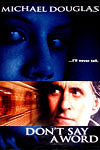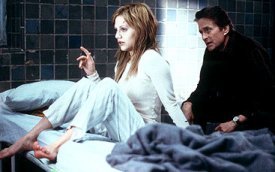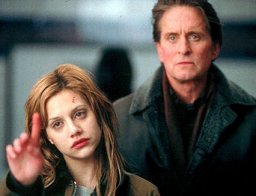|
Don't Say A Word
20th Century Fox may be the bravest studio in Hollywood right now. Don't Say A Word opens with a car bombing, closes with a character getting buried alive under rubble, and even dares to not CGI out the World Trade Center from the Manhattan skyline. That alone may be the bravest thing a studio has done in the last two weeks. And for that, Fanboy Planet applauds Fox. Seeing the World Trade Center makes us long for the days when watching Don't Say A Word would be the worst thing that could happen to our day.
The heavily made-up and hair-dyed Michael Douglas stars as Dr. Nathan Conrad, a crack child psychologist, famous for his "touch with teens." Living in a fabulous Manhattan apartment with his (of course) much younger wife Aggie (Famke Jannsen) and precocious daughter (Skye McCole Bartusiak), his life seems pretty perfect. Until the night before Thanksgiving, when an old co-worker (a weaselly Oliver Platt) calls him in to try and reach the catatonic Elisabeth (Brittany Murphy). She taunts him with the cryptic "You want…what they want…"
And the next morning, his daughter has been kidnapped. The kidnappers, led by Patrick Koster (Acuvue pitchman Sean Bean), will return her if Conrad can get a six-digit number out of Elisabeth's head. Why? Because ten years earlier her father had been involved in a heist that pointlessly opens the film, and double-crossed the gang. Somehow, her six digits (which may as well be her measurements, for all the clues Koster offers) hold the key to retrieving the loot - a single red ruby.
All the pieces seem to be there for a decent thriller. When they get put together, though, the complete picture looks like less than the sum of its parts.
To help generate suspense, the film borrows plot lines from other, better thrillers, smashing a lot together when any one done well would do. Rear Window mixes together with Sorry, Wrong Number, as Agga has a broken leg. Trapped in her bed, she waits helplessly for the kidnappers to call, knowing that - somehow - they can see her. (Improbably, they managed to run fiber optic cameras throughout the apartment while the Conrads slept. See, America? We're too complacent.)
Meanwhile the gang tracks Dr. Conrad wherever he goes, up to and through the Macy's Thanksgiving Day Parade (until it's convenient that they they lose him, even though the film reveals that the gang knows exactly where they need to go in the first place).
The precocious daughter charms her big lug of a guard into making her a peanut butter sandwich, and somewhere along the way a really hot police detective (Jennifer Esposito) stumbles across some other victims of the gang. Her importance to the story is almost non-existent, as she discovers nothing that we don't get shown elsewhere, and solves the crime too late. But she is hot.
None of it holds much suspense. For a film this long (just under two hours), there should be more build. Instead, the actual arcs get resolved quickly; we get cued that we just witnessed something important by the sudden insertion of slo-mo. (Can we ban this from filmmaking for at least a year, please?).
Elisabeth has confounded doctors for ten years. After skimming through her files for a half an hour, Conrad figures her out and breaks through to her by giving her his daughter's rag doll. Though we get told a lot of things about her mental problems, we only see a little of them. What should have been a psychological thriller ends up just being a chase movie.
Despite this, many of the actors come through looking pretty good. All the women wisely underplay their roles. As a result, Murphy ends up being one of the most real institutionalized characters in cinema in a long time. It won't win the Oscar, but it holds your attention. Janssen does what she can with her thankless role (she does just enough to avoid being replaced by a wooden puppet), and Esposito looks earnest enough as a cop.
The one person we really need to overact would be Bean. Clearly cast only because we know that the British make the best bad guys, he commits a cardinal sin: he's boring. Oh, he sneers just fine, but not often enough. Director Fleder may have convinced him that he would look cool, so often does he get shot in odd lighting, or behind beveled glass. It should make him look mysterious. It fails.
In the lead, Michael Douglas (or his wax effigy) simply plays nice. The role calls for it, but it makes for a boring hero. Douglas does best as a character with some flaws, and there really are not any here. He makes no mistakes, everything works for him, and because he carries no particular guilt for having done something wrong, we cannot feel the desperation he usually exudes so well.
To make up for the lack of real action and suspense, director Fleder (the better Kiss The Girls) uses a lot of heavy-handed visual tricks. Scenes set in the past get a nice solid tone wash, but not in consistent colors (externals are blue, interiors are amber, and then an exterior becomes amber). And for a couple of scenes, the villains get the blue wash treatment for no reason whatsoever.
A lot of action gets seen through either reflections or video screens, which probably seemed cool at the time but only distances us more. And Fleder does not trust the audience to understand his analogies either. Quick cuts of rag dolls and subway trains look arty, sure, but when they pay off, it ends up as patronizing.
Still, there is that shot of the World Trade Center. And yes, the audience whispered to each other when it came onscreen. Not a one of them hissed, "can we please go now?" Nope. We're staying. Even when the movie just isn't that good.
What's it worth? $3.99
Copyrights and trademarks for existing
entertainment (film, TV, comics, wrestling) properties are held by their
respective owners and are used with permission or for promotional purposes
of said properties. All other content ™ and © 2001 by FanboyPlanet.
If you want to quote us, let us know. We're media whores.
















